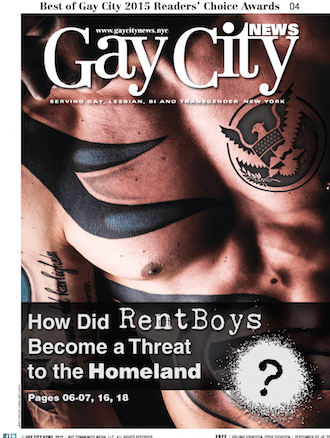The title characters of “Naz & Maalik” (Kerwin Johnson, Jr., and Curtiss Cook, Jr.) are gay, African-American, Muslim teenagers in Brooklyn. The film chronicles them spending the day on the street re-selling lottery tickets, saints cards, potions, and lotions — and stealing kisses. The boys have just spent their first night together, but are afraid to come out to their families. As they go about their day, Naz and Maalik encounter a cop (Bradley Brian Custer), a yuppie (David M. Farrington), and an FBI agent (Annie Grier), all of whom have their eyes on the boys. “Naz & Maalik” features a loose, episodic, and timely narrative, and the film gets by on the easygoing charm of its two leads.
Writer/ director Jay Dockendorf talked via Skype with Gay City News about his fine film.
GARY M. KRAMER: You are not gay nor African-American nor Muslim. How did you come to make a film based on these characters?
JAY DOCKENDORF: When I moved to New York, I found a place to stay in Bed-Stuy at Fulton and Nostrand. There’s a large Muslim population around that neighborhood: Halaal restaurants and incense shops, etc. I lived with a gay couple, one of whom was a closeted Muslim man in his 30s. He came randomly into my life, and I found his story dramatic and fascinating and compelling. He was Pakistani and I interviewed him, and he became a source for the film. I wanted the characters to be African-American. I felt like the experiences the characters would go through would be very relatable. Gay, black, and Muslim: that was a group of people I could and should represent because they would fit in the place I was living. I also thought it was interesting how many people in a particularly repressive community live in the closet and adapt to the adverse, difficult circumstances they do. I find that tragic and compelling, and probably very realistic.
Finding love as a young, gay, black Muslim in Brooklyn
GMK: What accounted for the approach you took with the narrative and creating the characters? How much of the film was improvised?
JD: My two closest friends in New York were gay men, and I spent a lot of time having ambulatory experiences with them. Some of the fights Naz and Maalik get into are angry discussions my friends had while we were walking through the city. Conversations that happen while walking are very natural; you get into a philosophical state of mind. I wanted to explore and capture that. Ten per cent or less of the film was improvised. There were some scenes on Fulton Mall that featured interactions that start with something scripted, but became improvised. A scene in the subway station bathroom was improvised.
GMK: “Naz & Maalik” is, unfortunately, very timely given the current attention to Muslims. Surely, this was not intended.
JD: The film was finished in March, and it’s strange that in the news two Muslim lovers committed an act of terror versus in the film two lovers that are suspected of terror. I wrote “Naz & Maalik” three years ago, but it took that long to be completed and distributed, and this is the current landscape. The characters are intelligent young men in a community that has little reason to fully trust police or FBI agents. They live in the city of Eric Garner, and they are profiled the entire day. I wrote this before, during, and after Michael Brown and Trayvon Martin and Tamir Rice who haunt the film in general and Naz and Maalik individually, though they never are mentioned by name.
I tried to make Naz and Maalik as smart as possible by having them talking about contemporary topics. I don’t want them to be a mouthpiece for a director of a different world and experience. I don’t have any skin in the game. In the film, an imam looks at a group of people who may not be who they say who they are, and he welcomes them. I’d heard about that speech from a real imam in Brooklyn. I was interested in putting that in the film with these characters, who have issues that are personal to me or to people I know.
GMK: Can you talk about the issues of terrorism and faith, jealousy and respect both on micro and macro levels?
JD: We wanted a certain amount of symbolic doubling that would lend the environment a bit of psychedelic paranoia. So audiences might think: are the events connected? The motion of this large world sweeps you up into a dream state, a wild ride. The themes all came from different places — the paranoia I heard in the interviews and conversations I had. “I think I probably shouldn’t come out, or behave this way, or say this thing…” That got under my skin, so I wanted to represent that to give that experience to people who saw the film — representative transference. Being a teen and wanting to do one thing, but needing to sneak past authority figures to achieve that goal creates suspicious behaviors that could arouse the attention of the police. These two teens are behaving mysteriously, which arouses local law enforcement with their surveillance.
GMK: What can you say about the film’s presentation of sexuality? It opens after the characters have first slept together and consider coming out.
JD: I wanted to show as much intimacy as I could get away with, with the story taking place in a single day. I felt that keeping that unity of time, place, and character was crucial. Different people can imagine losing one’s virginity different ways. A first night is too holy to depict. The afterglow and feeling connected is more universal. That became a conduit for trust and truth.
NAZ & MAALIK | Directed by Jay Dockendorf | Wolfe Releasing | Opens Jan. 22 | Cinema Village, 22 E. 12th St. | cinemavillage.com




































